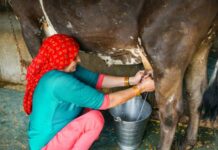New Delhi, April 09, 2021: At the center of any well managed nutrition programs lies these three components:
- Forages
- Feeds found in the ration
- Feedbunk management
According to Donna Amaral-Philips, a dairy Extension agent for the University of Kentucky, producers need to prioritize the three “F’s” in order to build an efficient nutrition program for their animals.
Forages
“High-quality forages are more digestible and result in more energy available to support higher milk production,” Amaral-Philips says. “In addition, less grain needs to be fed to meet her energy needs. Remember that energy is the hardest nutrient to get into your cows. With feed costs increasing, harvesting and storing high quality forages will be extremely critical, as always, but especially this year with higher feed and fertilizer costs.”
If you feed small grains such as oats, barley, wheat, rye or triticale, Amaral-Philips recommends harvesting at the boot stage of maturity before the seed head appears to help preserve quality. Additionally, forages should be tested for their nutrient values so the appropriate amount and composition of grain mix can be fed not only to the milking herd, but to heifers and dry cows as well.
Feeds Found in the Ration
Forages are the most economical source of nutrients and the more home-grown forages included in diets, the more economical rations potentially can become, Amaral-Philips notes.
“Cows need nutrients, not ingredients,” she says. “Remember that various feeds provide cows nutrients needed to support milk production, reproduction, growth of first calf heifers and health. Thus, some cost savings may be available with alternative ingredients for those who did not book feed at an established grain cost this past year. The key is to find a combination that supports the health and greatest income over feed costs. Thus, performance and cost savings are important as a package, not separately.”
Feedbunk Management
One often overlooked aspect of a nutrition program is the importance of feedbunk management. However, this management aspect has a major impact on milk production, reproduction and overall health of the cows in the milking herd, Amaral-Philip notes.
“The priority should always entail giving cows the opportunity to eat whenever they want, especially those fresh and early lactation cows,” she says. “For every pound of total mixed ration or combination of forage and grain equivalent to that found in a TMR that cows eat, generally enough energy is supplied to support a pound of milk. Attention to all of the details can easily be overlooked and taken for granted.”
Factors to keep in mind include:
- Feed (not refusals) is available at the morning feeding and feed amounts are adjusted to account for changes in group sizes and intake of cows.
- Feed is evenly distributed throughout the entire length of the feedbunk.
- Cows can easily reach the feed.
- TMR mixers are mixing feed so that the feed is uniformly mixed and delivered throughout the feedbunk.
- Cows have fresh feed upon return from milking.
- The feedbunk is cleaned out daily and there is enough feed fed so the bunk needs to be cleaned.
“Silages should be ensiled at 30-38% dry matter (or 62-70% moisture) and inoculants may be beneficial depending on the crop,” Amaral-Philips says. “Small grain silages will be in the lower end of the range whereas corn silage will be between 35 to 38% dry matter. Grasses and alfalfa silages benefit the most from the use of inoculants.”

























